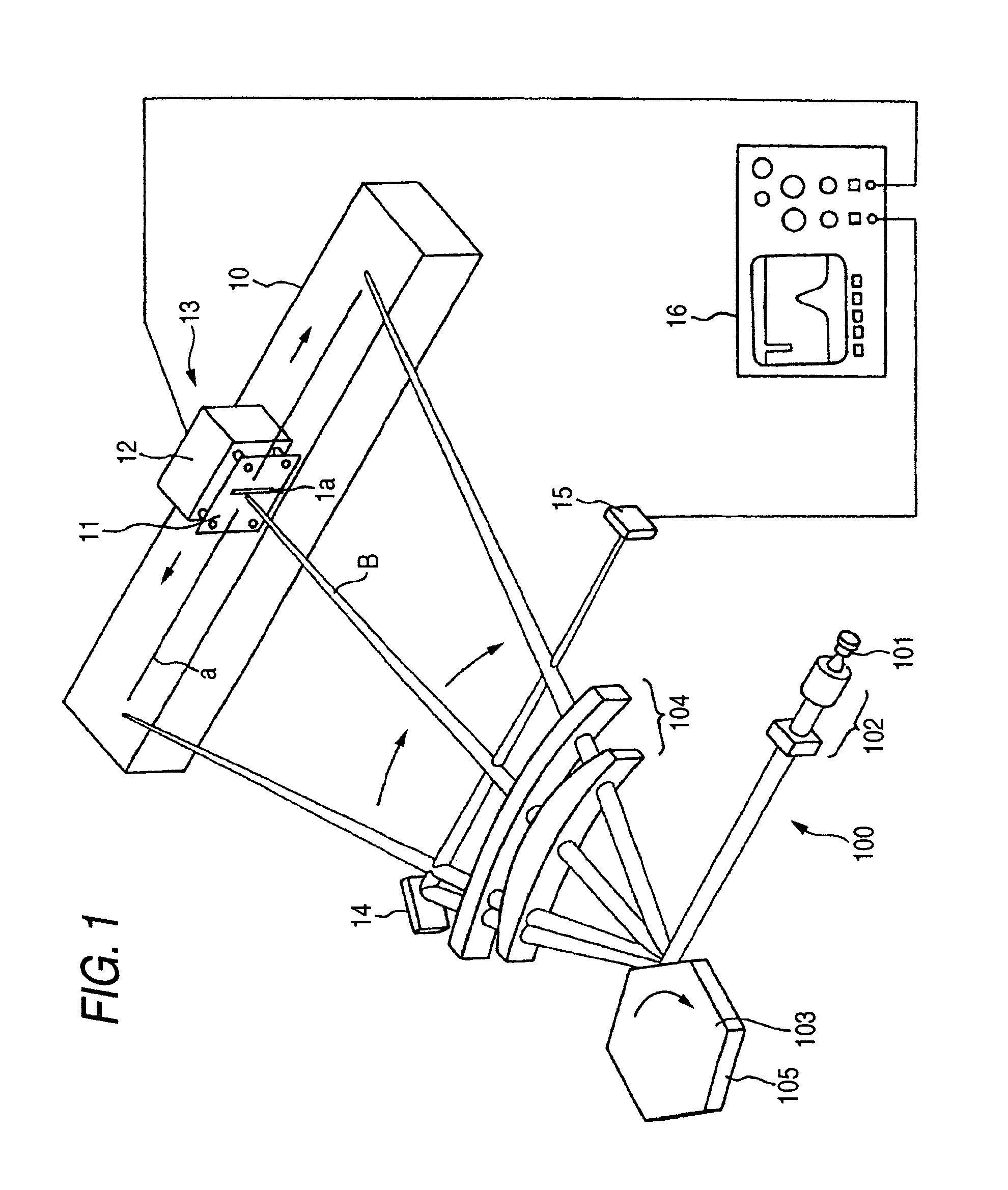Method and apparatus for measuring beam spot of scanning light
a scanning light and beam spot technology, applied in the field of methods and apparatus for measuring beam spots of scanning light, can solve the problems of inability to perform continuous evaluation throughout the primary scanning direction, inability to obtain accurate results, and apparatuses that can only measure stationary light beams
- Summary
- Abstract
- Description
- Claims
- Application Information
AI Technical Summary
Benefits of technology
Problems solved by technology
Method used
Image
Examples
first embodiment
[0063]FIG. 1 shows the invention which is an apparatus for measuring a focal condition of a scanning light beam. In this embodiment, a light scanning device 100 comprises a light source 101, a lens unit 102, a polygon mirror 103 and a scanning optical system 104. A light beam emitted from the light source 101 is converted into a parallel light beam by the lens unit 102, and incident on the reflection face 105 of the polygon mirror 103. The light beam is reflected and deflected by the reflection face 105 is converted into a scanning light beam B deflected in the direction of an arrow through the scanning optical system 104, and is focused on a scanned face. In a case where it is adopted an optical system for correcting a pyramidal angle error of a polygon mirror, the light beam emitted from the light source 101 is converted into a parallel light beam relative to a direction perpendicular to a rotation axis of the polygon mirror while being converted into a light beam to be focused in...
second embodiment
[0073]In this embodiment, the slit 1a is extended in the secondary scanning direction which is orthogonal to the x-axis. However, the extending direction of the slit 1 a may be inclined relative to the primary scanning direction. In this case, a spot size of the beam spot S in the oblique direction relative to the primary scanning direction or an inclined angle of the beam spot S can be continuously measured and evaluated. This case will be described below in detail as the invention.
[0074]As shown in FIG. 6, in the arrangement of FIG. 1, there is used a slit plate 11 in which a slit 1X and a slit 1Y are arranged in the primary scanning direction. The slit 1X extends in a direction inclined by +45 degrees (clockwise) from the secondary scanning direction. The slit 1Y extends in a direction inclined by −45 degrees (counterclockwise) from the secondary scanning direction. Herein, the slit widths in the primary scanning direction of the slits 1X and 1Y are smaller than a dimension in th...
third embodiment
[0081]In the above embodiments, the slit 1a provided on the slit plate 11 has a smaller width than the dimension of the beam spot S. However, if a slit 1b having a greater width than a dimension in the primary scanning direction of the beam spot S is provided as shown in FIG. 11A, it is possible to detect the power of the beam spot S. This case will be described below in detail as the invention. The slit 1b has a width in the primary scanning direction (x-axis) which is greater than the dimension of the beam spot S as described above. The moving velocity of the slit plate 11 is set to be sufficiently lower than that of the scanning light beam B. In a case where the beam spot S is moved over the slit 1b in the x direction, an optical power waveform obtained from the optical sensor 12 provided behind the slit plate 11 is shown in FIG. 11B, and a peak value P represents a value which is proportional to the power of the scanning light beam B without depending on the focal condition of t...
PUM
 Login to View More
Login to View More Abstract
Description
Claims
Application Information
 Login to View More
Login to View More - R&D Engineer
- R&D Manager
- IP Professional
- Industry Leading Data Capabilities
- Powerful AI technology
- Patent DNA Extraction
Browse by: Latest US Patents, China's latest patents, Technical Efficacy Thesaurus, Application Domain, Technology Topic, Popular Technical Reports.
© 2024 PatSnap. All rights reserved.Legal|Privacy policy|Modern Slavery Act Transparency Statement|Sitemap|About US| Contact US: help@patsnap.com










